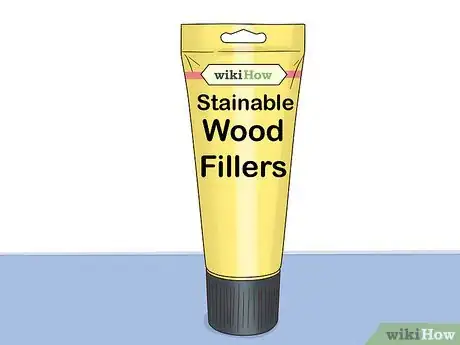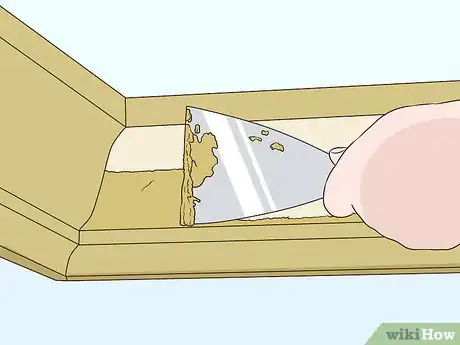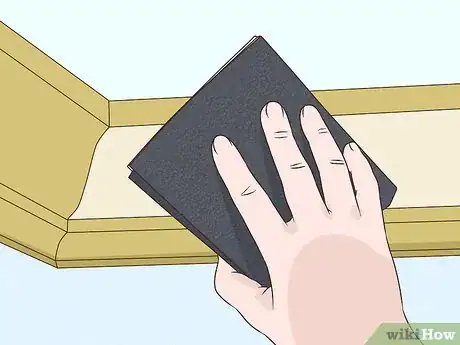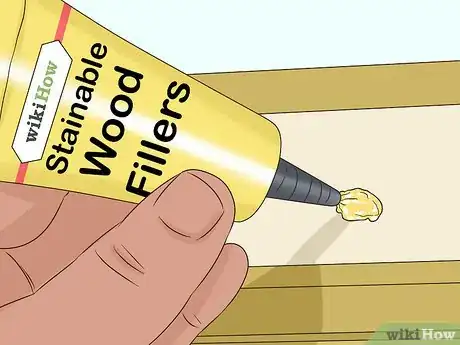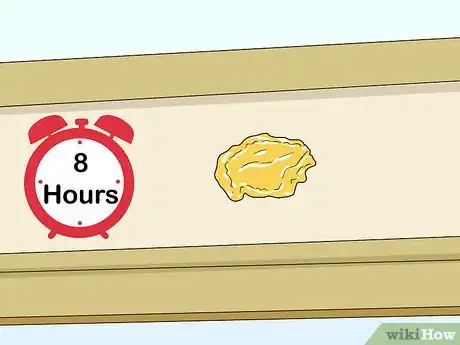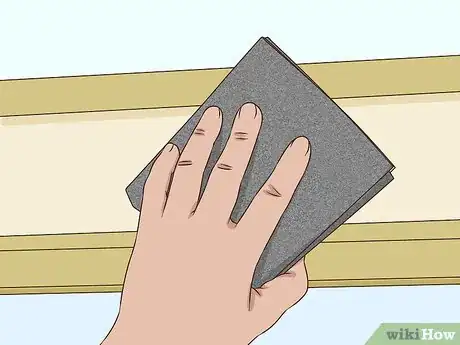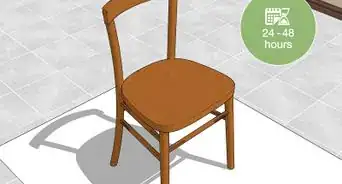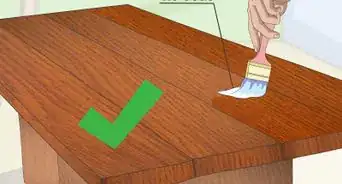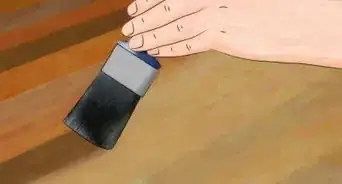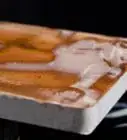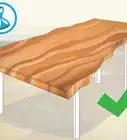This article was co-authored by Jeff Baldwin. Jeff Baldwin is a Residential Painter and the Owner of Baldwin Custom Painting. With two decades of painting experience, Jeff specializes in high-end residential and small commercial painting projects. Dedicated to quality craftsmanship, Jeff and Baldwin Custom Painting provide bonded/insured, licensed, and lead-safe certified services in residential painting, light commercial painting, and wood refinishing.
There are 8 references cited in this article, which can be found at the bottom of the page.
This article has been viewed 101,005 times.
Got a small gouge in some furniture you’d like to fix? Trying to finish that birdhouse you built from scratch but you’ve got a seam you just can’t fill? Wood filler is a great way to make small repairs and touch up woodworking projects alike. It’s also a total breeze to work with. In this article, we’ll show you everything you need to know about how to prep the surface, use the wood filler, and clean up the repair.
Steps
Preparing the Surface
-
1Buy or make an appropriate filler. Stainable wood fillers are designed to be stained so you can match them to the rest of the wood. Some water-based wood fillers are also stainable, but they are specifically meant to be used indoors.[1] You can also make your own wood filler by adding sawdust to carpenter's glue to form a paste.[2]
-
2Remove paint chips and wood splinters. If you see paint chips falling off, you need to take them off before repairing the wood. Flake them off with a scraper, getting off as much as you can. Similarly, scrape off any large splinters you see.[4]Advertisement
-
3Sand down the area. Rough edges can be detrimental when you're applying filler. Sanding those edges down will make the process go smoother for you. Check for rough edges directly around the damaged area.[5]
-
4Remove any debris. If you leave any loose debris or sawdust behind, the filler won't stick as well. Wipe it down with a damp tack cloth and then let it dry thoroughly. You can also use a shop vac if you have one.[6]
Filling the Hole
-
1Squeeze the filler into the hole. Use the tube to squeeze the filler into the area, making sure to fill in the deepest area by pressing the end down into it. Start at one end and gradually work your way to the other end.[7]
- If you don't have a tube, use a putty knife to apply it.
-
2Overfill the hole. When adding the wood filler, you need to fill it a bit more than level with the rest of the wood. That's because the filler shrinks a bit as it dries, so it will end up flush with the wood if you overfill it.[8]
- You only need to overfill it a little bit, maybe 5%.
-
3Smooth the filler out with a putty knife. Go over the filler with a putty knife to make a smooth area. Wipe off the knife and go over the area again if the first pass didn't get it as smooth as you'd like. Keep in mind you'll be sanding it later, so it doesn't have to be absolutely perfect.[9]
-
4Wait for the filler to dry. Once you've got the hole filled to your satisfaction, let the filler dry completely. It will be hard to the touch when it is dry. It may take up to 8 hours on a large or deep area, though it can dry in under half an hour.[10]
- Check the packaging for wood filler for specific drying times.
Finishing the Area
-
1Sand down the area until it is smooth and even with the wood. Use an orbital sander or standard sandpaper to sand down the area. Sand until the filler is evened out and it is level with the surrounding wood. Wipe it down to remove dust before painting or staining.[11]
-
2Check that the hole is filled in. Run your hand over the repaired area to see if it's smooth. Also, make sure you have filled in the hole and that it's level with the wood. Even if you filled in the hole completely, it may have settled out and left a depression or hole. If you haven't completely filled in the hole, repeat the process by adding more wood filler.
-
3Apply primer if you're painting the area. Most wood fillers can be painted, but fillers may affect how the paint looks. If you use primer first, it can help even out the look of the area.[12] This process works particularly well if you're painting a whole piece of furniture that you've repaired holes on.
-
4Paint or stain the area. Once you've got the repaired area perfectly level with the rest of the wood, you can apply paint or stain to match the rest of the wood.[13] If you're not sure of the paint or stain, you may want to test it first in an inconspicuous area to make sure it matches.[14]
- You can also test stain on a piece of scrap wood.
Expert Q&A
-
QuestionWhy is white pigmented shellac a good primer?
 Jeff BaldwinJeff Baldwin is a Residential Painter and the Owner of Baldwin Custom Painting. With two decades of painting experience, Jeff specializes in high-end residential and small commercial painting projects. Dedicated to quality craftsmanship, Jeff and Baldwin Custom Painting provide bonded/insured, licensed, and lead-safe certified services in residential painting, light commercial painting, and wood refinishing.
Jeff BaldwinJeff Baldwin is a Residential Painter and the Owner of Baldwin Custom Painting. With two decades of painting experience, Jeff specializes in high-end residential and small commercial painting projects. Dedicated to quality craftsmanship, Jeff and Baldwin Custom Painting provide bonded/insured, licensed, and lead-safe certified services in residential painting, light commercial painting, and wood refinishing.
Residential Painter White pigmented shellac is smooth and dries fast. It is stain-resistant and sands easily. Its smell dissipates quickly.
White pigmented shellac is smooth and dries fast. It is stain-resistant and sands easily. Its smell dissipates quickly. -
QuestionWhat if the stain isn't covering the stainable wood filler? It's lighter than the stain and I can see where all the holes and imperfections are. How do I correct this problem?
 Terry HeapsCommunity AnswerOld timer trick: Take a small blob of the filler and drip a few drops of the stain on it. Knead it together and apply.
Terry HeapsCommunity AnswerOld timer trick: Take a small blob of the filler and drip a few drops of the stain on it. Knead it together and apply.
Things You'll Need
- Wood filler
- Putty knife
- Tack cloth
- Sandpaper
- Primer, optional
- Paint or wood stain, optional
- Paintbrush, optional
References
- ↑ https://www.bobvila.com/articles/how-to-use-wood-filler/#.WfALqohrzIU
- ↑ https://www.thisoldhouse.com/how-to/how-to-choose-and-use-wood-filler
- ↑ https://www.familyhandyman.com/carpentry/how-to-use-epoxy-on-wood-for-repairs/view-all/
- ↑ https://www.bobvila.com/articles/how-to-use-wood-filler/#.WfALqohrzIU
- ↑ https://www.bobvila.com/articles/how-to-use-wood-filler/#.WfALqohrzIU
- ↑ https://www.bobvila.com/articles/how-to-use-wood-filler/#.WfALqohrzIU
- ↑ https://www.bobvila.com/articles/how-to-use-wood-filler/#.WfALqohrzIU
- ↑ https://www.thisoldhouse.com/how-to/how-to-choose-and-use-wood-filler
- ↑ https://www.bobvila.com/articles/how-to-use-wood-filler/#.WfALqohrzIU
- ↑ https://www.bobvila.com/articles/how-to-use-wood-filler/#.WfALqohrzIU
- ↑ Jeff Baldwin. Residential Painter. Expert Interview. 1 March 2021.
- ↑ Jeff Baldwin. Residential Painter. Expert Interview. 1 March 2021.
- ↑ https://www.bobvila.com/articles/how-to-use-wood-filler/#.WfALqohrzIU
- ↑ Jeff Baldwin. Residential Painter. Expert Interview. 1 March 2021.
About This Article
To use a wood filler, start by sanding down the surface you want to repair and removing any debris, which can prevent the filler from sticking. Then, squeeze the filler out of the tube into the affected area, beginning at the deepest part of the hole or crack. Make sure to overfill the hole a little bit, since wood filler shrinks when it dries. Next, smooth out the area with a putty knife before leaving the filler to dry for several hours. Finally, sand down the area until it's smooth and even. For tips on how to paint your wood after applying the filler, read on!
